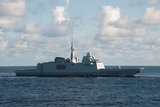China moves towards networked force
The People’s Liberation Army (PLA) of China is moving towards becoming an ‘informationised force’, according to its ‘China's National Defence in 2010’ white paper released on 31 March.
The paper said that significant progress had been made in building information systems for ISR, command and control, and ‘battlefield environment awareness’.
‘A preliminary level has been achieved in interoperability among command and control systems, combat forces, and support systems, making order transmission, intelligence distribution, command and guidance more efficient and rapid,’ the white paper said.
China plans to raise its defence budget by 12.7% to 601 billion Yuan (US$91.5 billion) in 2011. Although this is up from the 7.5% increase that was reported in 2010, the growth rate of defence expenditure has decreased.
‘In the past two years, the increase in the defence expenditure has been used to improve support for troops and accomplish diversified military tasks, ranging from earthquake rescue and effort operations in the Gulf of Aden and waters off Somalia,’ Beijing’s official press service said in a statement.
‘In view of the upward trend of purchasing prices and maintenance costs, China has moderately increased funding for high-tech weaponry and equipment.’
The government said that the total length of the national defence optical fibre communication network had been increased by a ‘large margin’, forming a new generation transmission network with optical fibre communication as the mainstay, and satellite and short-wave communications as secondary.
‘Information systems have been widely applied in logistics and equipment support,’ the statement said.
The US Department of Defense (DoD) issued its own report on the Chinese military’s capability in 2010, which said the PLA was pursuing the dual ideas of mechanisation and ‘informatisation’ (the application of information technology to military operations).
‘As a consequence, and in recognition of the high costs of force-wide refitting with state-of-the-art weapons systems, the PLA is selectively acquiring new generation technologies in some areas, while deferring new acquisitions in others in favour of upgrading older, but capable, systems for networked operations,’ the DoD said.
More from Digital Battlespace
-
![Babcock nears first customer for Nomad AI translation tool]()
Babcock nears first customer for Nomad AI translation tool
Nomad can provide militaries with real-time intelligence, saving critical time on the battlefield.
-
![AUSA 2025: Israel’s Asio Technologies to supply hundreds of improved Taurus tactical systems]()
AUSA 2025: Israel’s Asio Technologies to supply hundreds of improved Taurus tactical systems
Taurus operates alongside the Israel Defense Forces’ Orion system which supports mission management across tens of thousands of manoeuvring forces, from squad leaders to battalion commanders.
-
![AUSA 2025: Kopin pushes micro-LED plans as China moves faster]()
AUSA 2025: Kopin pushes micro-LED plans as China moves faster
The plan for the new displays follows fresh investment in Kopin’s European facilities by Theon and an order for head-up displays in fielded aircraft, with funding from the US Department of Defense.
-
![AUSA 2025: Persistent Systems to complete its largest order by year’s end]()
AUSA 2025: Persistent Systems to complete its largest order by year’s end
Persistent Systems received its largest ever single order for its MPU5 devices and other systems earlier this month and has already delivered the 50 units to the US Army’s 4th Infantry Division.
-
![Aselsan brings in dozens of companies and systems under the Steel Dome umbrella]()
Aselsan brings in dozens of companies and systems under the Steel Dome umbrella
Turkey has joined the family of countries attempting to establish a multilayered air defence system with government approval in August 2024 for the effort landed by Aselsan. Dubbed Steel Dome, the programme joins Israel’s Iron Dome, the US Golden Dome, India’s Mission Sudarshan Chakra and South Korea’s low-altitude missile defence system.
-
![DSEI 2025: MARSS unveils new agnostic multidomain C4 system]()
DSEI 2025: MARSS unveils new agnostic multidomain C4 system
MARSS’ NiDAR system has been deployed using sensors from static platforms to provide detection and protection for static sights, such as critical infrastructure, ports and military bases.



























